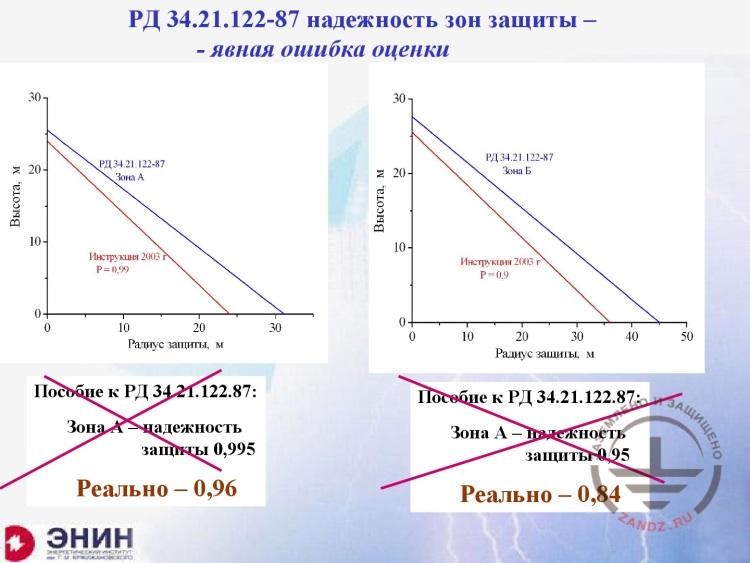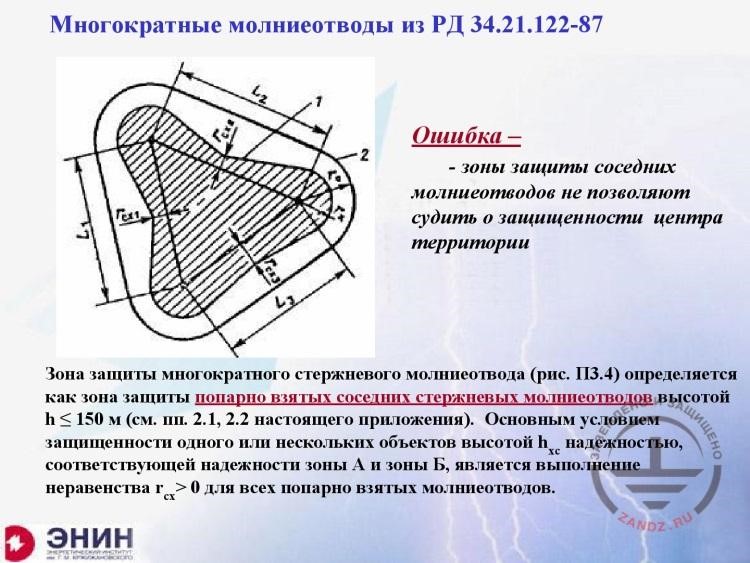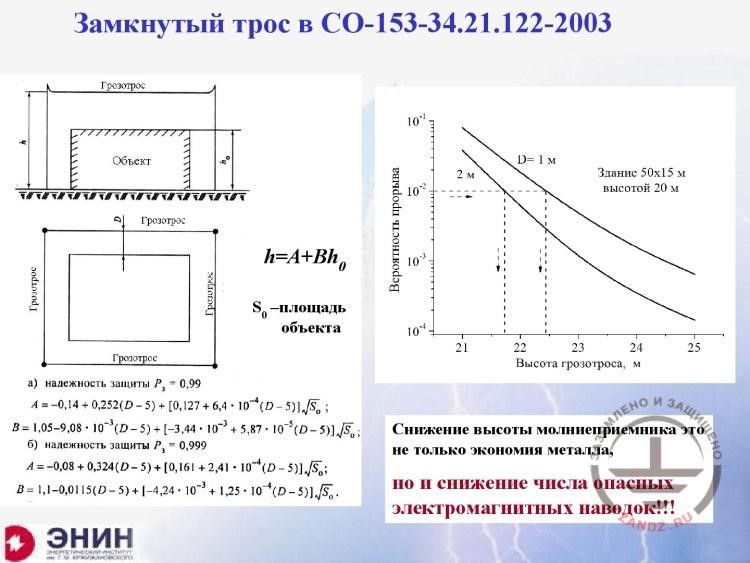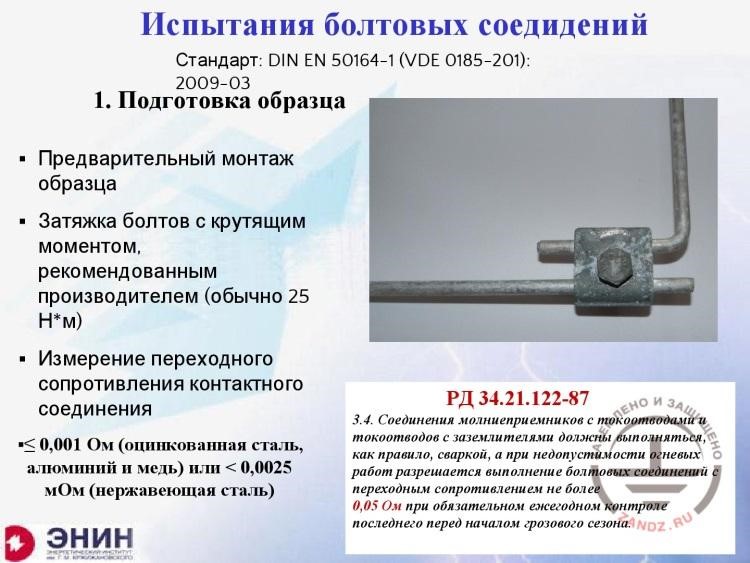The eighteenth webinar of "Earthing and Lightning Protection: Design Issues and Problems" series.
Webinar text. Page 2
Fast navigation by slides:
<< Page 1:
1. Conflicts in regulatory documents
2. Choosing external lightning arresters
3. Importance of height of a lightning arrester
4. Why is the IEC standard unacceptable?
5. IEC shielding angle method
6. Rolling sphere method
7. IEC methodology
8. RD and SO drawbacks
9. High lightning arrester: an obvious mistake!
10. Computer calculations
Page 2:
11. Protection zone reliability
12. Multiple lightning arresters
13. How to design without software?
14. Roof of a climate control device
15. Closed wire in SO-153
16. Parallels with the lightning rods
17. Problems when installing?
18. Bolt connection tests
19. How to be successful with Gostekhnadzor?
20. Earthing and lightning protection. IEC standard
Page 3: >>
21. Earthing in lightning protection. RD 34.21.122-87
22. The "Transneft" standard
23. Conductive coupling through the soil
24. Earthing circuit of an industrial facility
25. Creeping discharge hazard
26. Step and touch voltage rating
27. Step voltage at the 30 kA lightning current
28. Russian electrical safety standards
29. Lightning protection grid
30. Questions and answers
| РД 34.21.122-87 надежность зон защиты – явная ошибка оценки | RD 34.21.122-87 protection zone reliability: an obvious estimation error |
| Высота, м | Height, m |
| Высота, м | Height, m |
| Радиус защиты, м | Protection radius, m |
| Радиус защиты, м | Protection radius, m |
| РД 34.21.122-87 | RD 34.21.122-87 |
| Зона А | Zone A |
| РД 34.21.122-87 | RD 34.21.122-87 |
| Зона Б | Zone B |
| Инструкция 2003 г. | Instructions of 2003 |
| P = 0,99 | P = 0.99 |
| P = 0,9 | P = 0,9 |
| Инструкция 2003 г. | Instructions of 2003 |
| Пособие к РД 34.21.122.87: Зона А – надежность защиты 0,995 |
Attachment to RD 34.21.122.87: Zone A — protection reliability of 0.995 |
| Реально – 0,96 | Actual — 0.96 |
| Пособие к РД 34.21.122.87: Зона А – надежность защиты 0,95 |
Attachment to RD 34.21.122.87: Zone A — protection reliability of 0.95 |
| Реально – 0,84 | Actual — 0.84 |
– Now, let's discuss the issue of protection zone reliability. RD 34 does not contain any information on the protection zone reliability. It only provides one point: protection zone A is more reliable than protection zone B. But RD 34 contains an appendix stating that "protection zone A has a reliability of 0.995". It means that its protection reliability is higher than 0.99. But look at what it is really about. Here, protection zone A, and here, the actual protection zone having the reliability of 0.99. It is lower than in this zone, and the radius of the protection zone at the earth level here is approximately 7 meters lower. It means that such zone does not have any practical reliability of 0.995. Its actual reliability is 0.96. And it is much worse than the protection zone of the third reliability level described in document SO-153. It is an obvious mistake. Regarding type B zone I can say that this type B zone in these guidelines has the reliability of 0.95, which is a good value. But its actual reliability is 0.84. It is lower than the fourth protection level according to the effective regulatory document. We cannot consider these zones as high reliability zones in RD34. This is a gross mistake of the authors, that has preserved since 1987. Let's look further into this document.
| Многократные молниеотводы из РД 34.21.122-87 | Multiple lightning arresters from RD 34.21.122-87 |
| Ошибка – зоны защиты соседних молниеотводов не позволяют судить о защищенности центра территории | Error: the protection zones of the adjacent lightning arresters do now allow judging on the protection of the territory center |
| Зона защиты многократного стержневого молниеотвода (рис. П3.4) определяется как зона защиты попарно взятых соседних стержневых молниеотводов высотой h ≤ 150 м (см. пп. 2.1, 2.2 настоящего приложения). Основным условием защищенности одного или нескольких объектов высотой hXC надежностью, соответствующей надежности зоны А и зоны Б, является выполнение неравенства rCX > 0 для всех попарно взятых молниеотводов. | The protection zone of a multiple lightning rod (Fig. P3.4) is defined as a protection zone of the pairwise taken adjacent lightning rods having height of h ≤ 150 m (see sub-items 2.1, 2.2 hereof). The main condition for the protection of one or more facilities having the height hXC with the reliability that corresponds to the reliability of zone A and zone B is satisfying the inequality rCX > 0 for all the lightning arresters taken in pairs. |
– Let's talk about the protection zones of multiple lightning arresters. What does document RD 34 say about them? Because SO-153 does not contain any information about the multiple lightning arresters at all. It states as follows: the protection zones of the lightning arresters should be calculated pairwise for the adjacent lightning arresters. And if such zones do not have a drop to zero level, all the space inside of them, which is dashed in the figure, are considered to be protected reliably. If you check this using the probabilistic method, you will see that it is an obvious mistake. The protection zone inside is not associated with the protection zones of the lightning arresters taken in pairs. We can ask nobody about how this direction appeared in RD 34, because the authors of this regulatory document have already deceased. But we cannot use it.
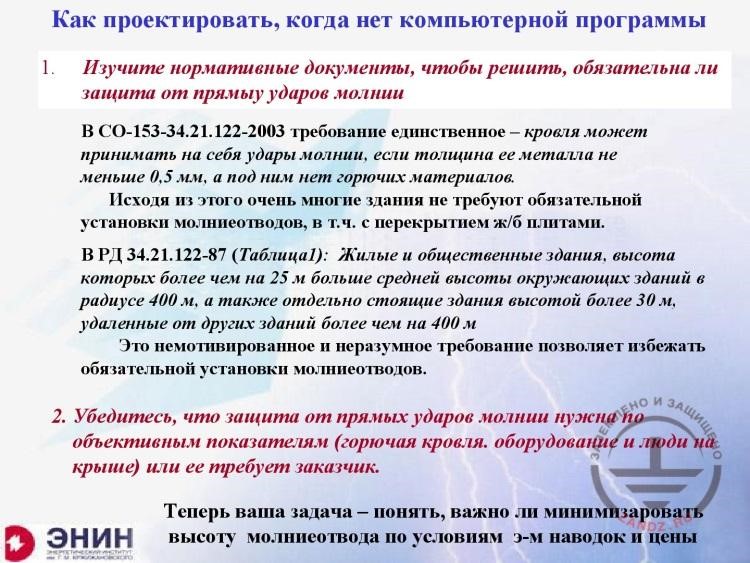
How to make designs without software?
| Как проектировать, когда нет компьютерной программы | How to make designs without software? |
| 1. Изучите нормативные документы, чтобы решить, обязательна ли защита от прямых ударов молнии | 1. Examine regulatory documents to decide on if the protection against direct lightning strikes is required? |
| В СО-153.34.21.122-2003 требование единственное – кровля может принимать на себя удары молнии, если толщина ее металла не меньше 0,5 мм, а под ним нет горючих материалов. | In SO-153.34.21.122-2003, only one requirement is specified: the roof may accept the lightning strikes if its metal is not less than 0.5 mm thick and does not contain the flammable materials underneath. |
| Исходя из этого очень многие здания не требуют обязательной установки молниеотводов, в т.ч. с перекрытием ж/б плитами. | Based on this, many buildings do not require the mandatory installation of the lightning arresters, including those that contain the reinforced concrete plates. |
| В РД.34.21.122-87 (Таблица 1): Жилые и общественные здания, высота которых более чем на 25 м больше средней высоты окружающих зданий в радиусе 400 м, а также отдельно стоящие здания высотой более 30 м, удаленные от других зданий более чем на 400 м | In RD.34.21.122-87 (Table 1): residential and public buildings, the height of which exceeds the average height of the surrounding buildings within the radius of 400 m as well as separate buildings of over 30 m high spaced from other buildings for more than 400 m, by more than 25 m. |
| Это немотивированное и неразумное требование позволяет избежать обязательной установки молниеотводов. | Such unjustified and unreasonable requirement allows avoiding the mandatory installation of lightning arresters. |
| 2. Убедитесь, что защита от прямых ударов молнии нужна по объективным показателям (горючая кровля, оборудование и люди на крыше) или ее требует заказчик. | 2. Make sure that the protection against the direct lightning strikes is required upon objective indicators (flammable roof, presence of equipment and people on the roof) or if the customer requires it. |
| Теперь ваша задача – понять, важно ли минимизировать высоту молниеотвода по условиям э-м наводок и цены | Now your task is to understand whether it is important to minimize the lightning arrester’s height in terms of electromagnetic interference and price |
– How can you draw up designs if you do not have software for calculations and if you could not address the "Earthing and Lightning Protection at ZANDZ.com" project and access the trial version of the software that is available online? What should you do? The first point to begin with is that I would first read thoroughly the currently effective Russian regulatory documents. Do we need to provide lightning protection or not? How would I look at that? Document SO-153 contains no instructions on the need of lightning protection. But we should consider document RD 34. It is worth doing it. Document RD 34 contains information on when we have to protect residential and public buildings, if they are located in the urban area. It turns out that we have to protect them in case their height is 25 meters more than the average height of the buildings located within the 400-meter radius in this region. Thus, there are very many objects that require lightning protection, but according to this regulatory document, you may exclude them. And if this is a separate object, which is, e.g., located outside the urban area, then you can protect it according to these standards only if it is over 30 meters high, and there is nothing around the object within the 400-meter radius. These are formal requirements. Based on these formal requirements, in many cases you can say to the customer: "Lightning protection for your object is not required". You can use SO-153 as well. It states that if you have got a roof, and the thickness of this roof is more than 0.5 mm, then this roof can be used as a lightning arrester.
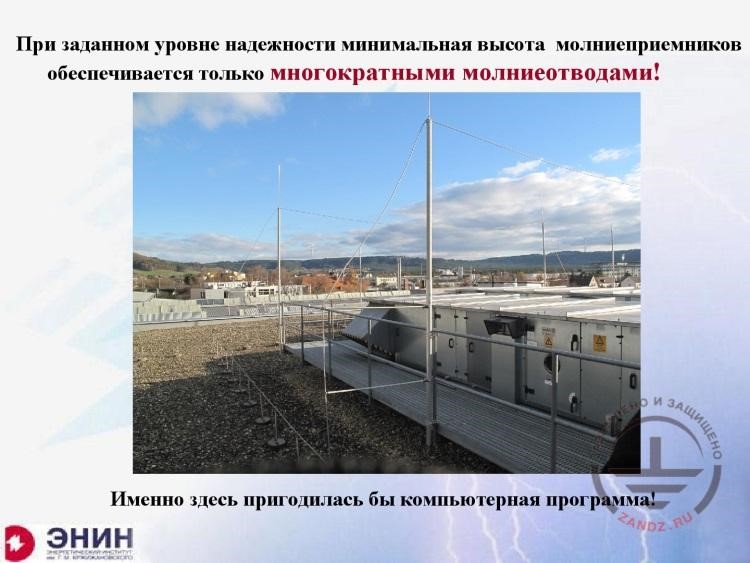
Roof with a climate control device
| При заданном уровне надежности минимальная высота молниеприемников обеспечивается только многократными молниеотводами! | With the established reliability level, the minimum height of the lightning arresters is provided only by multiple lightning arresters! |
| Именно здесь пригодилась бы компьютерная программа! | A software would be suitable here! |
– Now, the major point. I am going to protect the roof while concerning that, like on that photo, there are climate control devices installed on the roof. I want to protect the climate control devices so that building height would not increase significantly. What can we do for this? We can either install high lightning arresters, but I do not want to do it as we can only install few of them, or install a series of lightning arresters with small elevations. Look at my photo. The lightning arresters are about 3 meters high and they are installed at the step of about 6 meters. In this case, you will not be able to calculate the protection zones, because there is no such possibility. What can we do? How can we get round of this and prove that these lightning arresters may be installed?
| Замкнутый трос в СО-153-34.21.122-2003 | Closed wire in SO-153-34.21.122-2003 |
| Грозотрос | Ground wire |
| Объект | Facility |
| Вероятность прорыва | Breakthrough probability |
| 2 м | 2 m |
| Высота грозотроса, м | Ground wire height, m |
| Здание 50х15 м высотой 20 м | Building 50 x 15 m, 20 m high |
| Снижение высоты молниеприемника это не только экономия металла, но и снижение числа опасных электромагнитных наводок!!! | Reduction in the lightning arrester’s height not only leads to the metal savings but also to the reduction in the number of dangerous electromagnetic interference!!! |
| а) надежность защиты Pз = 0,99 | a) protection reliability Pp = 0.99 |
| б) надежность защиты Pз = 0,999 | b) protection reliability Pp = 0.999 |
– Document CO-153 contains another, completely different type of lightning arresters. These are closed wire lightning arresters that are installed along the external building perimeter, surrounding the building from all sides. Here is the building in plan view. These are the lightning arresters installed. Here, in the figure, they are taken out externally with the negative tilt for about 1–2 meters. And it turns out that if we make these lightning arresters, then, e.g., as it is shown in the next chart here, the protection zone at the height of 20 meters provides the protection of 0.99, which is ensured by the lightning arresters elevated by only 2 meters above the roof. You know, it is not an elevation. It is rather challenging to make a wire lightning arrester. Can you avoid it? Yes, you can. In what cases can we avoid them? In the following case. I take two lightning arresters in pairs and look at their protection zones. And if these protection zones do not have a drop in the middle, they will provide exactly the same lightning protection as the wire. You may perform calculations then.
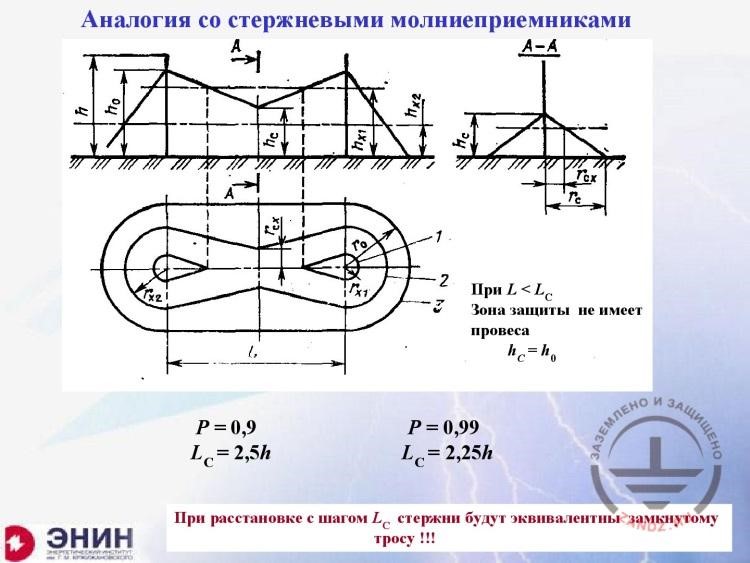
Parallels with the lightning rods
| Аналогия со стержневыми молниеприемниками | Parallels with the lightning rods |
| При L < LC Зона защиты не имеет провеса |
At L < LC, The protection zone does not have a slack |
| При расстановке с шагом LC стержни будут эквивалентны замкнутому тросу!!! | If they are installed with a step LC, the rods will be equivalent to the closed wire! |
– If there is no such drop, then in this case, the distance between the lightning arresters should be equal to about two-and-a-half their heights. And then such lightning arresters can be installed, and they may provide high protection reliability if you install them along the roof perimeter. The question is: when you go to the customer and tell him/her that you want to install 20 lightning rods on the roof, he/she may not like it for the following reason.
| Проблема монтажа? – исчезает, если отказаться от сварки | Installation problem? — It disappears if you do not use welding |
| Молниеприемник | Lightning arrester |
| Клемма для молниеприемника | Terminal for lightning arrester |
| Опора для молниеприемника | Support for lightning arrester |
| Держатель для проводника диам. 8-10 мм | Holder for a conductor with a diameter of 8 to 10 mm |
– He/she will not like it because he or she will say: "How can I do that? The lightning arresters must be welded and then secured by means of welding. It means hot works and problems. I do not want them." And I need to say that, in Europe, the lightning arresters are not installed by means of welding. Our Russian documents require welding, and the lightning arresters in Europe are installed on the roof as follows. This is a foundation made of concrete slugs. A metal shaft protrudes therefrom having a height of about half a meter. The lightning rod is lowered into such shaft and secured using bolt connections. The quality of this fastening is such that, in the aggressive environment saturated with sulfur vapors and acid evaporations, these bolt connections provide a transient contact with the value of not more than 0.003 Ohm. What do we have? Can I use it or not? It turns out that yes, I can.
| Испытания болтовых соединений | Testing bolt connections |
| Стандарт: DIN EN 50164-1 (VDE 0185-201): 2009-03 | Standard: DIN EN 50164-1 (VDE 0185-201): 2009-03 |
| 1. Подготовка образца | 1. Preparation of a sample |
| Предварительный монтаж образца | Preliminary installation of a sample |
| Затяжка болтов с крутящим моментом, рекомендованным производителем (обычно 25 Н*м) | Bolt tightening with the torque recommended by the manufacturer (typically 25 N*m) |
| Измерение переходного сопротивления контактного соединения | Measurement of a transient resistance of a contact connection |
| ≤ 0,001 Ом (оцинкованная сталь, алюминий и медь) или < 0,0025 мОм (нержавеющая сталь) | ≤ 0.001 Ohm (zinc-coated steel, aluminum, and copper) or < 0.0025 mOhm (stainless steel) |
| РД 34.21.122-87 | RD 34.21.122-87 |
| 3.4 Соединения молниеприемников с токоотводами и токоотводов с заземлителями должны выполняться, как правило, сваркой, а при недопустимости огневых работ разрешается выполнение болтовых соединений с переходным сопротивлением не более 0,05 Ом при обязательном ежегодном контроле последнего перед началом грозового сезона. | 3.4 Lightning arrester connections with the current collectors and current collectors with earthing devices should be usually made by welding, and when the hot works are not permitted, then it is allowed to use bolt connections having the transient resistance of not more than 0.05 Ohm with the mandatory annual control of the latter before the storm season. |
– I can, because if I read RD 34 carefully, I will see that the connections should not be made by means welding, but they usually should be made with the aid of welding. And if hot works are not permitted, then the bolt connections can be used with the transient resistance of not more than 0.05 Ohm. But you can always ask the customer to prohibit hot works. And you cannot perform welding there. And after that, you can buy such bolt connections I am talking about, which have been thoroughly tested for transient resistance. By the way, these things in Russia have been produced by our Russian companies for a long time. I assure you that they are not worse than the German ones. And you can do it such that one lightning arrester of 3 meters high I am talking about is installed in the intended location for about 5–10 minutes. The point is that you will also need 5–10 minutes to remove it.
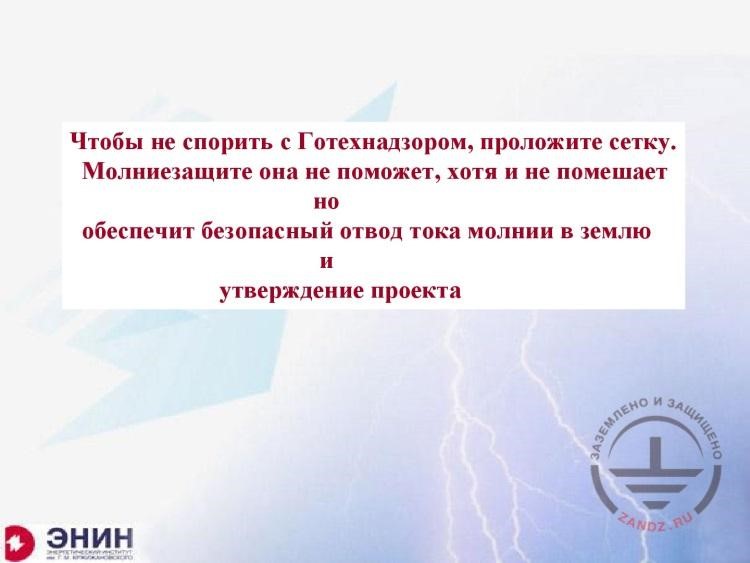
How to be successful with Gostekhnadzor?
| Чтобы не спорить с Гостехнадзором, проложите сетку. | Install a grid to avoid disputes with Gostekhnadzor. |
| Молниезащите она не поможет, хотя и не помешает, но обеспечит безопасный отвод тока молнии в землю и утверждение проекта | It will not be of any help for lightning protection, although it will not affect it, but provide safe current drainage to the earth and the design approval |
– Now, how to be successful when dealing with Gostekhnadzor? This is a serious point. This is a serious point. Gostekhnadzor will come to you and say: "Hey, where is the grid? You have to install the lightning protection grid on the roof, but you do not have one". I am going to talk about the grid at the end, intentionally. I can tell you only one thing now. This grid does not provide any benefit except for only one, which is, if you install it, Gostekhnadzor will leave you alone. Besides, when using this grid, you will be able to integrate all lightning arresters that will be installed on the roof into one system and balance distribution of the current that flows from the grid to the earth along the current collectors. Thus, the electromagnetic environment in the building interior volume will be of higher quality, and it does not really matter that the grid does not function as the lightning arrester. But Gostekhnadzor will be leave you alone.
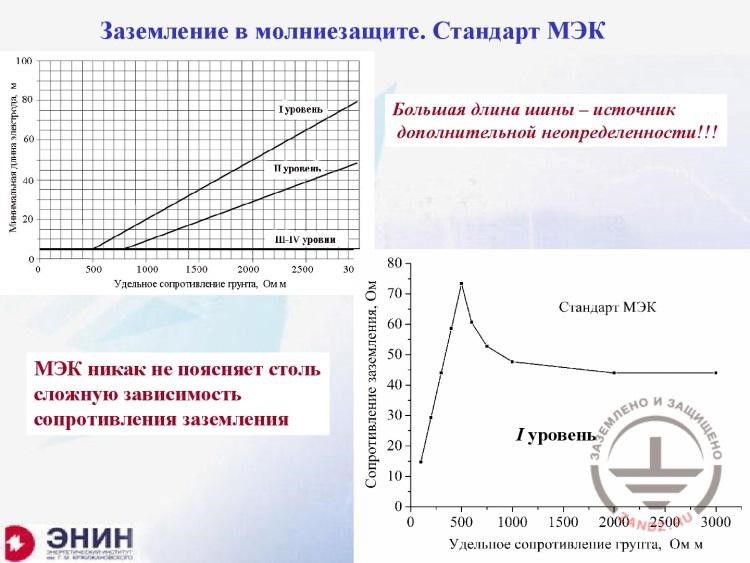
Earthing in lightning protection. IEC standard
| Заземление в молниезащите. Стандарт МЭК | Earthing in lightning protection. IEC standard |
| Минимальная длина электрода, м | Minimum electrode length, m |
| Удельное сопротивление грунта, Ом*м | Soil resistivity, Ohm*m |
| I уровень | Level I |
| II уровень | Level II |
| III-IV уровень | Level III–IV |
| МЭК никак не поясняет столь сложную зависимость сопротивления заземления | IEC does not provide any explanation for this complex dependence of earthing resistance |
| Большая длина шины – источник дополнительной неопределенности!!! | Large bus length is a source of additional uncertainty!!! |
| Сопротивление заземления, Ом | Earthing resistance, Ohm |
| Удельное сопротивление грунта, Ом*м | Soil resistivity, Ohm*m |
| Стандарт МЭК | IEC standard |
| I уровень | Level I |
– Now, I want to talk about earthings. I will start again with the IEC standard. In IEC standard 62305, the following banner is shown. This picture has been taken from the IEC standard. Look, it is shown here, what length of the lightning protection bus must be depending on the soil resistivity. The situation is as follows: up to the resistivity of 500 Ohm*m, the length of this bus is the same — it is equal to 5 meters in all points. The bus length increases in a linear fashion along with the increase in the resistivity. It looks like a good recommendation that is very easy to follow. And then, I will do the following: I use these dimensions and generate the actual earthing resistance depending upon the soil resistivity. Look at what I obtained. First, the earthing resistance will grow along with an increase in the resistivity, then it will start decreasing, and after that, it will stabilize.
<< Previous page
slides from 1 to 10
Next page >>
slides 21 to 29 + questions and answers
Related Articles:


 Lightning Protection of Large Territories: Parks, Grounds, Plant Territories. Page 1
Lightning Protection of Large Territories: Parks, Grounds, Plant Territories. Page 1
 Lightning Protection of Large Territories: Parks, Grounds, Plant Territories. Page 2
Lightning Protection of Large Territories: Parks, Grounds, Plant Territories. Page 2
 Lightning Protection of Large Territories: Parks, Grounds, Plant Territories. Page 3
Lightning Protection of Large Territories: Parks, Grounds, Plant Territories. Page 3


